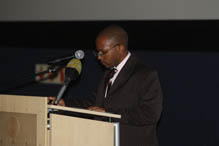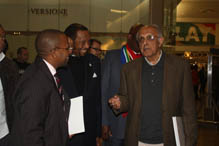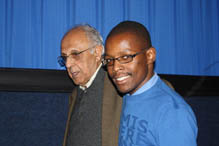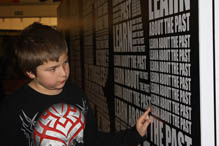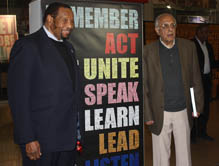
Businessman Richard Maponya with anti-apartheid stalwart Ahmed Kathrada at the launch of the Mandela Day International Exhibition
June 30, 2010 – In the run up to Mandela Day on July 18, a new exhibition on Nelson Mandela curated by the Nelson Mandela Foundation’s Centre of Memory and Dialogue opened last night at Maponya Mall in Pimville, Soweto.
The seven pillars upon which the exhibition is based illustrate Madiba’s legacy. They are: act, unite, speak, learn, listen, lead and remember.
The Foundation’s information communications manager, Sello Hatang, said at the opening that the exhibition “is a key milestone in the 2010 Mandela Day campaign”. He explained that the Mandela Day campaign “calls on people throughout the world to devote just a mere 67 minutes of their lives on Mr Mandela’s birthday to doing good.”
The 67 minutes people are asked to devote to doing good is symbolic of the 67 years Mr Mandela devoted to serving his community, his country and the world.
Among the guests at last night’s opening were anti-apartheid veteran Ahmed Kathrada, businessman Dr Richard Maponya who developed the mall – the first in Soweto – and after whom it is named, Minister of Science and Technology Naledi Pandor, and staff of the Nelson Mandela Foundation.
Kathrada, who, with Mr Mandela, was convicted and sentenced in the Rivonia Trial to life imprisonment, reminded those present that his friendship with Mr Mandela does indeed go way back.
“We know one another from a long time ago.
We were in prison together for a long time, in the same trial, the Rivonia Trial, and after 18 years on Robben Island, we were transferred together to Pollsmoor Prison,” Kathrada recalled.
Kathrada’s talk focused on Mr Mandela’s leadership. “Prison is the place where one sees the best and the worst of people,” he remarked. “Temptations are great, but hardships greater.”
Kathrada recalled that the apartheid government “had a 90-day [detention] policy, where we had no visitors, no lawyers and one was kept in complete isolation.
The only visitors were the police, who would come to see you from time to time.” He described this policy as “extreme psychological torture”.
“When we saw our lawyers for the first time after 90 days, they told us from the very first day, ‘Chaps, prepare for the worst.’
That is where Madiba came in; he told us this is a political trial.” Mr Mandela reminded his fellow trialists that, “All of you who are in the witness box must proclaim your beliefs,” because they believed the death sentence was on its way.
Kathrada remembered Mr Mandela’s long speech from the dock at the opening of the defence case on 20 April 1964: “He ended that by saying he fought during his life for equality and justice, and if need be, he would be prepared to die for that.”
After being sentenced to life imprisonment, the prisoners soon realised that separation wasn’t only outside in the form of apartheid, but that prisoners were classed and separated according to their skin colour. White prisoners were held at different prisons and Indians and coloureds were treated differently from black prisoners.
For example, Kathrada explained that he got just a bit more sugar than Mr Mandela, but that Denis Goldberg, a white Rivonia Trialist who had also been sentenced to prison, got more sugar than he did.
There was a point, Kathrada recalled, where Mr Mandela was offered the same food as Indians and coloureds, as well as exemption from work, and he refused, saying, “We are in prison, we are not leaders and we don’t make policy or give instructions. We are just ordinary leaders and have leaders outside prison to do that.”
Kathrada paid homage not only to Mr Mandela, but also acknowledged the contribution of popular businessman Maponya, now in his 80s.
“He stood by us before we were imprisoned, he stood by us during our imprisonment and he stood by us after we were released from prison. When we heard the good news happening outside about him, we knew there were people outside who were keeping the flag flying and that did a lot for our morale,” said Kathrada.
In closing, Kathrada assured guests that the exhibition was “very well worth seeing”.
Talking about the upcoming Mandela Day, Maponya said, “We should do something so that it’s cast in stone. I believe we need to identify a project that we could put together with Mandela Day to eliminate poverty in our country.”
Maponya added, “For us to remember this day well, we should remember, as Madiba says, ‘It’s in our hands’, and [the alieviation of] poverty is in our hands.” He continued,“Mandela Day is a fantastic day where I always think of people who have nothing and I always want to extend a hand of help in whatever way I can.
We must declare war against poverty the same way we declared war against apartheid,” he said.
Maponya ended with these remarks, “This is a fantastic exhibition that is telling the whole story of our icon. I think all our people should come and see this exhibition, to learn where we come from and where we’re going.”
For Kathrada the exhibition is Mr Mandela’s coming home.
“Madiba, when he went underground, was a Sowetan ... this exhibition has brought him back to Soweto,” said Kathrada.
Reflections:
“This is history, Nelson Mandela is our father, the first black president of South Africa, and we grow up with our parents telling us that we are so lucky because we never experienced apartheid. Most achievers today are people who come from the apartheid time and they are still here for us to learn from them. We know little and we’re still trying to learn more.” – Matumelo Prudence Mthimkhulu, a volunteer exhibition guide
“It’s nice that it is in Soweto, where people can find out a bit about their history. It is nice to be here and get the feeling of local people and understand a bit more about Nelson Mandela. I will be back in Argentina [on Mandela Day], but will do something to use my bit of experience of South Africa and what I know of Madiba.” – Carlos Miller, from Argentina
“It’s great to bring Nelson Mandela’s history to a place where real people come every day. Although everyone knows the history, being here where people can access the history better is great. On Mandela Day, I will be a part of the celebrations that the Foundation organises. I honour Nelson Mandela and that’s why I’m here. Since 1983, we have been trying to build our democracy. With over 30 000 deaths and even more people missing before our democracy, we have empathy with the struggle that South Africa went through to get liberation.” – Carlos Sersale di Cerisano, Argentina’s ambassador to South Africa.
“This is an excellent portrayal of Madiba’s life.” – Ahmed Kathrada, anti-apartheid stalwart
“To commemorate Mandela Day I would like us to declare war [on] and eradicate poverty. Industry people and communities must get involved, it’s in our hands.” – Richard Maponya, businessman and CEO of Maponya Group
“We see this exhibition as a milestone for the Mandela Day campaign. We hope those who visit it will be more empowered to do good every day. Communities must get involved and make every day a Mandela Day.” – Sello Hatang from the Nelson Mandela Foundation
